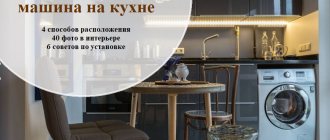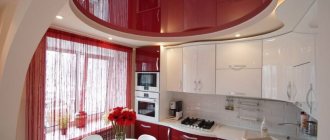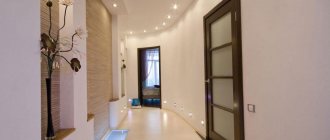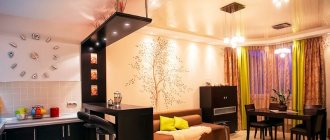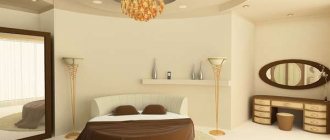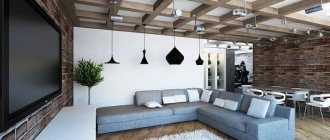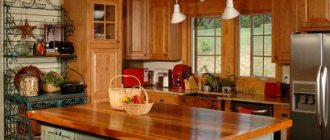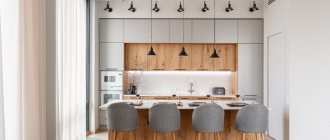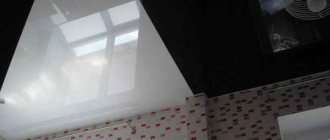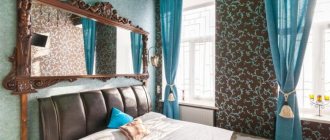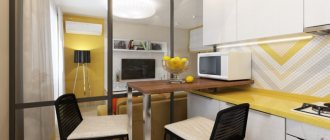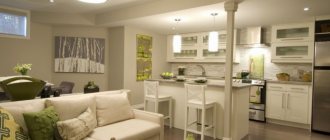The ideal wife is always the unconditional mistress of the kitchen, if you create suitable conditions for her and fill the space with comfort. Finishing the ceiling surface is one of the main touches on the way to this. The choice of materials is truly great, but numerous photos convince us that the ceiling in the kitchen made of plasterboard looks no worse than popular stretch fabrics, and in some ways even surpasses them. Read more about this with numerous photo examples of the best design options below.
The finishing of the ceiling surface of gypsum boards has become rapidly widespread along with the introduction of numerous options for additional lighting in the room. Specialists have successfully mastered this magical, in some cases, zoning tool and generously shared fresh ideas with numerous clients. The requirements of the kitchen space for the material placed on the ceiling matched perfectly with the characteristics of plasterboard - and beautiful design projects, full of interesting compositions and ideas, began to be actively implemented.
Ceiling installation methods
To install suspended options, a frame is constructed from a metal profile. Between the drywall and the ceiling, voids form in which communications are hidden. Depending on the complexity, the structure hides from 10 to 20 cm, so it is not suitable for small rooms.
Plasterboard construction Source prorab.help
For a kitchen with a ceiling below 2.7 m, hemming technology is chosen. Drywall is attached to the floor slabs. The strong, rigid design, due to the absence of suspensions, almost does not take away the height of the room. The option only conceals the thickness of the sheet and the sheathing.
A simple option for a room Source remontcap.ru
Combined structures combine the characteristics of suspended and hemmed types. Varieties on a rigid frame are often complemented by tension fabrics, which allows you to obtain a surface of varying complexity. Great for zoning and creating unusual designs.
Single-level
A simple, inexpensive design without frills - a universal solution for spaces of different sizes. A single-level plasterboard ceiling in the kitchen is suitable for “Khrushchev” buildings and low rooms. Visually, the technology is no different from traditional design. This option will ideally hide surface unevenness, help hide pipes, cables and install lamps.
Simple indoor ceiling Source idealkuhnya.ru
Painting a single-level ceiling in different colors is used for visual zoning of the kitchen. Combining intense and muted shades allows you to draw attention to the desired element. The unequal textures above the working and dining areas look impressive.
A simple plasterboard option for the kitchen Source idealkuhnya.ru
Single-level plasterboard ceilings in the kitchen can be decorated with 3D prints. Three-dimensional pictures are printed separately and then glued to the sheet. The method allows you to bring mood into the room, visually enlarge and deepen the space above your head.
Two-level
The design is suitable for solving complex technical problems and creating an unusual interior. The structures hide centimeters of usable space, so they are used for large kitchens. Air ducts, wiring and recessed lighting fixtures are hidden under the two-level option.
Model of two tiers Source justinterior.ru
Complex option for the kitchen Source sdelaipotolok.com
The base of the structure is assembled from plasterboard or mounted to a permanent ceiling. The second tier is slightly smaller than the base one and is decorative in nature. Combining different protruding elements helps designers create unusual structures. When decorating, geometric and abstract details are used, often complemented with stretched canvas and photo prints.
Multi-level
Complex structures consist of many components. Each layer occupies a minimum of 10 cm, so it is suitable for rooms with a high ceiling (from 3 m). Pipes and ventilation, wiring and lighting fixtures are hidden under multi-level plasterboard structures.
Plasterboard ceiling in kitchen design Source interstel.ru
Complex designs are used to visually smooth out the disproportions of kitchens in “Stalin” buildings. The height of the rooms often exceeds 4 m, which makes the space uncomfortable. Designers combine parts of different thicknesses and shapes, add tension fabrics or place a three-dimensional pattern on the surface. The overhead area turns out to be very decorative and luxurious.
About the advantages and disadvantages
If you have not encountered this type of ceiling, it will be useful to know what their pros and cons are. Let's talk first about plasterboard ceilings.
When installed, they reduce the size of the room by at least a few centimeters. Plasterboard ceilings are resistant to dampness and are suitable for spacious rooms with good ventilation - this significantly limits their use in kitchen spaces.
Another advantage is the following feature: behind such a ceiling covering you can hide all communications. Also, gypsum is a rather heavy material, the work itself is difficult to install and time-consuming. In addition, the purchase of a large amount of material is required; during the work there will be quite a lot of debris and dust. But in terms of price, this option is cheaper and more environmentally friendly. The environmental friendliness of the material in a place like a living space is important, you will agree.
Stretch ceilings also take away part of the space from the height of the room; ventilation and wiring are also well hidden behind them. This material is completely waterproof and is not afraid of humidity and even flooding from neighbors above! In addition, manufacturers guarantee that the appearance and colors will not deteriorate within 20 years of operation. This option will be more expensive, but it is also more durable, installation is easier, and there is almost no waste. The perfect flatness of the ceiling surface is worth the cost!
Types of finishing
Plasterboard ceilings in the kitchen are located in an aggressive environment (humidity, high temperature). To protect surfaces, 5 paint options are used:
- Water-based. An inexpensive, unstable coating with a wide palette of shades will have to be updated frequently.
- Acrylic. The finish is not afraid of moisture, it can be washed and placed above the stove.
- Silicate. Beautiful durable paint with antiseptic properties. Disadvantage: pungent odor.
- Water-dispersed. The budget-friendly coating with high moisture resistance can withstand washing with a wet cloth.
- Silicone. The enamel forms a thin elastic film on the surface of the plasterboard ceiling and does not stink. The material “seals” cracks up to 2 mm thick.
Materials for design Source yandex.ua
Designers decorate the space above the head with decorative plaster. The Venetian one, imitating a stone pattern, looks luxurious. Bright mosaic options and spectacular silk ones are often used. The finish of the plasterboard ceiling echoes the elements on the kitchen walls.
Stone ceiling Source obustroeno.com
Designers use tiles when decorating cooking areas. The surface above the head is decorated with a combination of mirror and opaque (colored, ceramic) elements. The kitchen looks luxurious and expensive, and decorative inserts visually raise the ceiling.
Plasterboard surfaces are often covered with film and supplemented with photo printing. You can place the night sky (stars) or day sky (clouds) above your head. Natural motifs (plants, animals) and seasons and weather have a calming effect. The kitchen ceiling is “turned” into a window, placing the ocean or tourist attractions “behind the glass”.
Design of a plasterboard ceiling in the kitchen Source sdelaipotolok.com
Plasterboard surfaces are decorated with hand painting. Author's images will add zest to the kitchen design. To make the finish look voluminous, use liquid paper. Patterns, abstractions and national ornaments are appropriate in design. Fragments from famous paintings or passages of text written in calligraphic font are often used.
Ceiling in the kitchen with designer painting Source sdelaipotolok.com
Colors
The shades in the design of a plasterboard ceiling in the kitchen depend on the interior and technical characteristics of the room. A monochromatic finish is considered traditional, which is used in both single-tier and complex structures. The area above the head is done in light colors:
- white;
- beige;
- pink;
- gray
A monochromatic design allows you to visually expand the space and not draw attention to the ceiling. Pastel colors in the design of a small kitchen will add a touch of coziness. To prevent the color from boring, multi-tiered structures combine shades of different intensities or temperatures.
Decorating with one color in the kitchen Source piramida-stroi.ru
Combined ceilings (contrasting, monochrome) attract the eye to the finishing details. When choosing a color, use no more than 3 tones, otherwise the design will get boring and irritate. You can use both soft gradient transitions and sharp polarity. Dark and light parts help in zoning the kitchen.
Contrasting kitchen design Source dizainvfoto.ru
Plasterboard ceiling for a small room
The small size of the kitchen ceiling cannot become an obstacle to the creation of a plasterboard structure. You need to choose a suitable design.
- for low rooms, it is preferable to choose a single-level ceiling.
- Playing with lighting schemes and lighting the cornice will help diversify a boring single-level ceiling.
- Light colors will help expand the space.
- glossy textures will visually increase the area of the room.
Current styles
Suspended or hemmed structures are used in the design of all directions. The versatility of the material allows you to implement the most daring design ideas in the room. The complexity and decorativeness of the plasterboard ceiling in the kitchen depends on the chosen style.
Classic, neoclassical
The headroom flows in an elegant direction to match the room's decor. In “Khrushchev” buildings, single-tier structures in white (cream) color are appropriate. Along the perimeter of the ceiling there is a cornice, the decor of which repeats the patterns on the facades or wallpaper. The demonstrative simplicity of the classic design looks very expensive.
In a kitchen with a high ceiling (from 3 m), two-level options are appropriate. In the design of the area above the head, geometric details (rectangles, ovals) are placed, framed by a plinth. Curly elements can be combined with tension fabrics. The design uses stucco in doses, giving preference to strict forms.
Symmetrical kitchen design Source yandex.ua
Neoclassicism combines the elegance of traditional design and modern finishes. The geometric symmetry of the plasterboard ceiling is emphasized by mirror tiles. Reflective material is installed in the center of the structure, with a single-color coating around the perimeter. The kitchen turns out very bright and beautiful.
Updated design with plasterboard ceiling Source yandex.ua
The updated classics use both simple ceiling solutions and multi-level models. Due to the neutral design, the area above the head does not attract attention. LED lighting emphasizes the boundaries of space. An accent design element is a chandelier or built-in flat lamp.
Baroque
The style involves a rich and complex design, which also affects the ceiling. Multi-level plasterboard structures will help realize original design ideas. The direction is best used in large, tall kitchens of “Stalin” buildings or country houses.
In Baroque, the ceiling is traditionally made in snow or cream color, although there are contrasting options (black and white, brown and beige). Complex stucco molding and shaped structures are appropriate in the design. Gilding or bronze painting (borders, three-dimensional designs) adds luxury to the design.
Plasterboard ceiling in luxurious design Source design-homes.ru
Baroque plasterboard ceilings can be reminiscent of the classical style in structure. Strict geometric shapes are complemented by stretched fabrics with photo printing. Hand-painted and three-dimensional painting is often used in decoration. The subjects of the images are floral ornaments or excerpts from mythological works.
Loft
The plasterboard ceiling in the kitchen is often decorated in an industrial style. The design focuses on straight, clear lines and angles. A structure is built overhead that imitates massive wooden beams or copper pipes. Brickwork or metal-based coating, reminiscent of factory partitions, looks unusual.
If the kitchen is small, then the ceiling is made flat. A structure that replicates the rough texture of concrete will harmoniously fit into the design of the loft. The neutral gray shade is complemented by movable lamps (spots on rails). The surface above the head can be decorated in white. Traditional whitewash is combined with brutal lamps on pendants.
High tech
Plasterboard ceilings for the kitchen become a striking design element. The interior style uses multi-level structures that combine several types of materials. The shaped parts are combined with tension fabrics made of glossy PVC. A play of contrasts and sharp transitions from light areas to dark areas are appropriate.
In a high-tech interior, protruding geometric squares on the ceiling look luxurious. The clarity of the lines is emphasized by built-in lamps and LED elements along the perimeter of the structure. Stepped details above the head often repeat the shape of a headset or “island”, creating visual zoning.
Modern design with complex structure Source homester.com.ua
In a high-tech kitchen, a plasterboard ceiling can imitate beams. The bleached version resembles a piece of wood with holes. Lighting fixtures are placed under the sheathing or highlighted in a contrasting color. The design style often uses a laconic, flat surface, placing accents with lamps.
Country
Plasterboard ceilings in a rustic kitchen should be in keeping with the spirit of the direction. The whitewashed area above the head will visually increase the space and look very natural. The design can use both perfectly smooth and rough textures. Different surfaces will help divide the room into zones.
Cozy country kitchen Source potolokjournal.ru
Plasterboard ceiling with lighting
Lighting plays an important role in many design decisions. Lighting creates a unique kitchen design in which you can relax and enjoy. Without putting in a lot of effort, you can create lighting with your own hands; you just need to have the desire and define a number of tasks.
Lighting designs are:
- with open lighting (implies built-in lighting fixtures or simple hanging ones);
- with hidden lighting (lighting fixtures are mounted in special niches).
When creating lighting, fluorescent or LED lamps are usually used, but other options are also possible.
Note!
Linoleum for the kitchen - master classes on installing linoleum in the kitchen interior. The best design ideas and color schemes (120 photos)Illumination of the work area in the kitchen: TOP-130 design options. Rules for selecting and installing lighting in photo reviews
Stretch ceiling in the kitchen - TOP-130 design options for stretch ceiling in the kitchen + photo examples
Forms of figured ceiling
An exclusive surface finish helps create a unique kitchen design. Complex ceiling structures look impressive and expensive. For decorative structures, multi-level models and special flexible material are often used.
Rectangles
A figured plasterboard ceiling in the kitchen is a traditional option that fits a room of any size. The middle of the part is made thin, and the edges are denser. The geometric element is mounted in the center of the room or divides the space into small squares.
Figured ceiling made of rectangles Source liderstroy57.ru
To highlight the beauty of the design, lamps are installed in the structure. A chandelier or many small light bulbs are mounted in the middle of the figure; an LED strip is appropriate around the perimeter. The movement of the ceiling is visually created. Different colors and lighting schemes will give the interior the mood.
Color scheme, drawings, stucco molding
Since we are talking about the design of the kitchen space, light or, if desired, bright colors will be preferable. It is necessary to remember the effect of color on appetite. Blue, violet, cyan - reduce appetite; red, yellow, orange - increase.
If you decide to make a modern ceiling with a pattern, or even with a 3D image, we will tell you about the most appropriate and popular pictures for the kitchen space. How to make a choice? What's suitable? We suggest: the most popular are photos of fruits and berries, images of a blue sky with airy clouds, plant motifs - images of flowers or leaves. The photo printing possibilities are endless; you can take any photo, even your own portrait!
Curly ceilings with 3D patterns look very beautiful, pay attention to such options, you may want to keep up with world fashion, because it is now gaining popularity.
If you have a kitchen in a classic style and you want to decorate the room with stucco, this will be appropriate when using a figured ceiling. Patterned stucco can be located near the lamp or along the periphery, to suit your taste.
Lighting selection
The ability to use any lighting fixtures is the main advantage of plasterboard structures. The wiring is hidden in the ceiling box, and the decorative elements are brought out. With artificial light, both a perfectly flat surface and a complex cascade structure look luxurious.
Indoors, designers strive to create multi-level lighting. Lighting elements for plasterboard ceilings are divided into 3 types:
- Backlight. The diode strip is attached around the perimeter of the structure or to shade the tiers. Models come in neutral white (yellow) and colored.
- Built-in devices. The components are mounted in line with the ceiling. The rays are concentrated, so highlights and penumbra do not appear on the surface. They are available in both miniature and dimensional sizes.
- Lamps on pendants. Traditional models with long or short base. Lampshades (plafonds) are used as decoration. There are options with a movable “leg”.
In plasterboard ceilings, designers combine different types of light, trying to create an individual solution for a specific design. For each zone, a separate circuit is made, which is illuminated by a group of devices. The technology allows you to save energy without compromising convenience and decorativeness.
Different types of lighting in the kitchen Source ivd.ru
